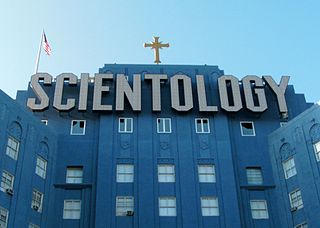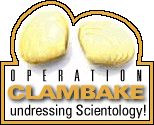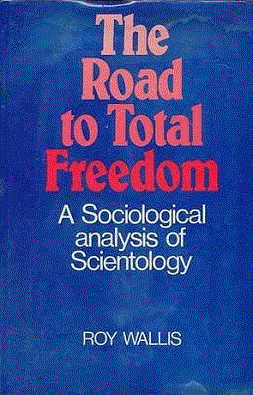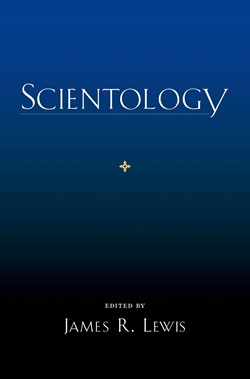
Xenu, also called Xemu, is a figure in the Church of Scientology's secret "Advanced Technology", a sacred and esoteric teaching. According to the "Technology", Xenu was the extraterrestrial ruler of a "Galactic Confederacy" who brought billions of his people to Earth in DC-8-like spacecraft 75 million years ago, stacked them around volcanoes, and killed them with hydrogen bombs. Official Scientology scriptures hold that the thetans of these aliens adhere to humans, causing spiritual harm.

The Cult Awareness Network (CAN) was an anti-cult organization founded by deprogrammer Ted Patrick that provided information on groups it considered "cults", as well as support and referrals to deprogrammers. It operated from the mid 1970s to the mid 1990s in the United States.

Free Zone, Freezone, and Independent Scientology are umbrella terms for the groups, organizations, and individuals who practice Scientology beliefs and practices independently of the Church of Scientology (COS). Such practitioners range from those who closely adhere to the original teachings of Scientology's founder L. Ron Hubbard, to those who have adapted practices far from COS beliefs and practices.

The Church of Scientology maintains a wide variety of beliefs and practices. The core belief holds that a human is an immortal, spiritual being (thetan) that is resident in a physical body. The thetan has had innumerable past lives, some of which, preceding the thetan's arrival on Earth, were lived in extraterrestrial cultures. Based on case studies at advanced levels, it is predicted that any Scientologist undergoing auditing will eventually come across and recount a common series of past-life events.
The anti-cult movement, abbreviated ACM and also known as the countercult movement, consists of various governmental and non-governmental organizations and individuals that seek to raise awareness of cults, uncover coercive practices used to attract and retain members, and help those who have become involved with harmful cult practices.

Dianetics: The Modern Science of Mental Health, sometimes abbreviated as DMSMH, is a book by L. Ron Hubbard about Dianetics, a pseudoscientific system that he claimed to have developed from a combination of personal experience, basic principles of Eastern philosophy and the work of Sigmund Freud. The book is considered part of Scientology's canon. It is colloquially referred to by Scientologists as Book One. The book launched the movement, which later defined itself as a religion, in 1950. As of 2013, New Era Publications, the international publishing company of Hubbard's works, sells the book in English and in 50 other languages.

Stephen A. Kent is a professor in the Department of Sociology at the University of Alberta in Edmonton, Alberta, Canada. He researches new religious movements (NRMs), and has published research on several such groups including the Children of God, the Church of Scientology, and other NRMs operating in Canada.

Scientology founder L. Ron Hubbard explicitly compared his teachings to the science-fiction subgenre space opera. In his writings, wherein thetans were reincarnated periodically over quadrillions of years, retaining memories of prior lives, to which Hubbard attributed complex narratives about life throughout the universe. The most controversial of these myths is the story of Xenu, to whom Hubbard attributed responsibility for many of the world's problems.
Scientology has been referenced in popular culture in many different forms of media including fiction, film, music, television and theatre. In the 1960s, author William S. Burroughs wrote about Scientology in both fictional short stories and non-fictional essays. The topic was dealt with more directly in his book, Ali's Smile/Naked Scientology. The 2000 film Battlefield Earth was an adaptation of a novel by L. Ron Hubbard.

History of Dianetics and Scientology begins around 1950. During the late 1940s, L. Ron Hubbard began developing a mental therapy system which he called Dianetics. Hubbard had tried to interest the medical profession in his techniques, including the Gerontological Society, the Journal of the American Medical Association, and the American Journal of Psychiatry, but his work was rejected for not containing sufficient evidence of efficacy to be acceptable.

Freedom is a magazine published by the Church of Scientology since 1968. The magazine describes its focus as "Investigative Reporting in the Public Interest." A frequent topic is psychiatry, which Scientology strongly opposes.

Misunderstanding Cults: Searching for Objectivity in a Controversial Field is an edited volume discussing various topics related to cults, including the scholarly field itself, the concept of brainwashing, and the public perception of the groups. The book was edited by Benjamin Zablocki and Thomas Robbins, and was published by University of Toronto Press on December 1, 2001. It includes contributions from 12 religious, sociological, and psychological scholars, in 14 essays.

James R. Lewis was an American philosophy professor at Wuhan University. He was a religious studies scholar, sociologist of religion, and writer, who specialized in the academic study of new religious movements, astrology, and New Age.

The relationship between Scientology and religious groups is very complex. While Scientology claims that it is fully compatible with all existing major world religions and that it does not conflict with them or their religious practices, there are significant contradictions between Scientology and most religions, especially the major monotheistic religions. Members are not allowed to engage in other similar mental therapies or procedures, religious or otherwise.

Scientology is a set of beliefs and practices invented by the American author L. Ron Hubbard, and an associated movement. It is variously defined as a cult, a business, a religion, a scam, or a new religious movement. Hubbard initially developed a set of ideas that he called Dianetics, which he represented as a form of therapy. An organization that he established in 1950 to promote it went bankrupt, and Hubbard lost the rights to his book Dianetics in 1952. He then recharacterized his ideas as a religion, likely for tax purposes, and renamed them Scientology. By 1954, he had regained the rights to Dianetics and founded the Church of Scientology, which remains the largest organization promoting Scientology. There are practitioners independent of the Church, in what is referred to as the Free Zone. Estimates put the number of Scientologists at under 40,000 worldwide.

Operation Clambake, also referred to by its domain name, xenu.net, is a website and Norway-based non-profit organization, launched in 1996, founded by Andreas Heldal-Lund, that publishes criticism of the Church of Scientology. It is owned and maintained by Andreas Heldal-Lund, who stated that he supported the rights of all people to practice Scientology or any religion. Operation Clambake has referred to the Church of Scientology as "a vicious and dangerous cult that masquerades as a religion". The website includes texts of petitions, news articles, exposés, and primary source documents. The site has been ranked as high as the second spot in Google searches for the term "Scientology".

The Road to Total Freedom: A Sociological Analysis of Scientology is a non-fiction book about Scientology by sociologist Roy Wallis. Originally published in 1976 by Heinemann, it was republished in 1977 by Columbia University Press. The original manuscript was the product of Wallis's doctoral research at Oxford under the tutelage of Bryan Wilson. Wallis, after a review of the original manuscript by Scientology leaders, made edits to about 100 passages before publication.
The "New Cult Awareness Network" is an organization that provides information about cults, and is owned and operated by associates of the Church of Scientology, itself categorized in many countries as a cult. It was formed in 1996, with the name purchased from the now defunct Cult Awareness Network, an organization that provided information on groups it considered to be cults, and that strongly opposed Scientology.
The New Vigilantes: Deprogrammers, Anti-Cultists, and the New Religions is a 1980 nonfiction book on anti-cultism, deprogramming, and new religious movements (cults) by sociologists of religion Anson D. Shupe and David G. Bromley. A foreword was written by Joseph R. Gusfield. It was published by SAGE Publications in its Library of Social Research series as volume 113. Some have described the volume as a companion to their previous work, "Moonies" in America: Cult, Church, and Crusade (1979). Shupe and Bromley approach the anti-cult movement in the United States through a resource-mobilization lens.









